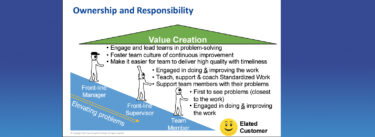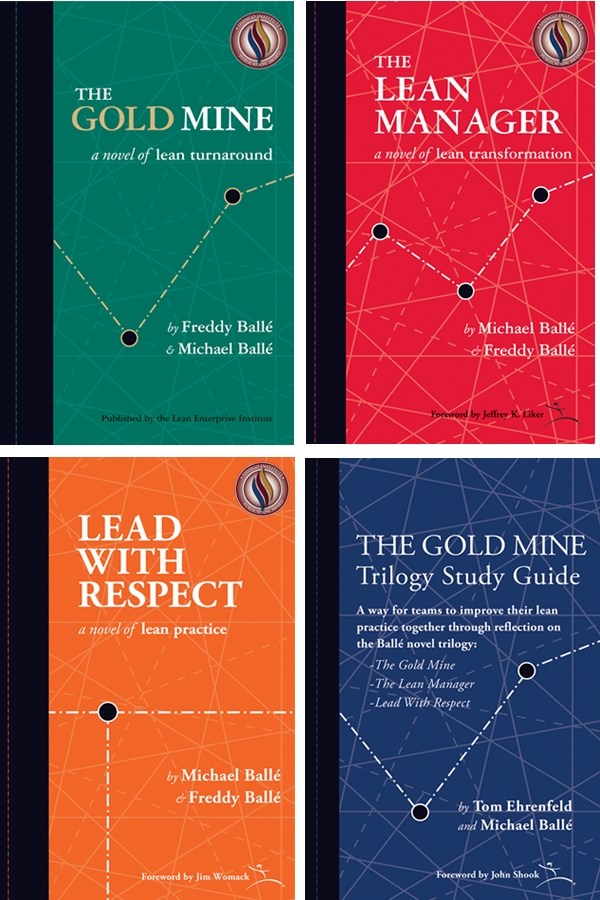At the end of the lean management webinar “How to Lead with Respect,” we had a couple of hundred questions left over that presenter and author Michael Ballé didn’t have time to answer.
After reviewing the questions, several main themes emerged. We’ve selected your questions that best represent those themes and present them here with answers from Michael.
Q: Can you give examples of two improvements that can only happen within relationships to help me better understand this concept?
A: Teaching lean thinking to the COO of a new company. In shipping, we start with a Truck Preparation Area — the logistics manager simply doesn’t want to hear about it. In Production, with production analysis boards, the supervisor agrees to do it, but they are not very interested. In Engineering with project kanban, the engineering manager takes to it immediately. As time goes by, the relationship with the logistic manager deteriorates, the relationship with the production supervisor remains neither good nor bad, the relationship with the engineering manager becomes great as we all get excited with new discoveries, new ideas for progress, new possibilities and initiatives. It’s a chicken and egg thing, but clearly the strength of the relationships permits better teaching (which is mostly about repeat, repeat, repeat) and so quicker progress.
Q: Have you seen this process applied to Human Resources work?
A: Not yet, but this is a very interesting discussion we’re having with HR specialists here in France. It looks very promising. What we see so far is how HR can support the process: (1) support the middle-management PDCAs as an internal university, (2) support shop floor “dojos,” (3) support the suggestion process and (4) last but not least, help operators with their specific problems.
Q: Leading with respect will sometimes necessitate mentoring up with respect, which can be difficult. What do you typically do when mentoring up in difficult situations?
A: There is always some balance between force and relate. I obviously prefer relate and I’m very lucky inasmuch as I mostly only work with people I get on well. But occasionally, particularly in the early days, I don’t hesitate to force some people, particularly in the matter of setting up visual control. In the end, this is a very human thing so there is never a right balance between challenge and support, and also conditions change rapidly. The importance, I feel, is to keep in mind that people’s self-confidence is a key element of success, so it’s OK to push, but never to put down, and also, you can’t always control everything. The trick is to realize that people’s on-the-spot reaction doesn’t necessarily reflect their conclusions if they get time to think and reflect. It is a challenge, and there’s never a perfect solution. In the end, I find it usually sorts itself out – or stops completely. Either case, problem solved.
Q: During the presentation, you said, “They learn, you learn! Can you explain it more?
A: This is probably the most intriguing and fascinating part of leading with respect. Most of what we do is about what we feel is possible, not possible and, in between, not impossible.
As you improve operations, some issues progressively go away because people fix them, but they often open new fronts. As they do, they sometimes have new initiatives that, as a boss, you’ve never envisioned. For instance, technically, a programmer can suggest open source rather than proprietary software. Or someone can suggest that to source the entire product at low cost, you could source the parts and keep assembly close to engineering. Or investigate how big data could revolutionize the way to use the product and so on.
When people come up with kaizen ideas, they’re solving their own local problem. But, as a senior manager, if you’re open minded, sometimes you see far larger opportunities. As they learn to solve their problems, you learn to see your strategy and policies differently.
Q: How can you make people get more involved with the process and learn that if they do things wrong, it will not help them or the company.
A: The question is: how do they know what is right and what is wrong. We’ve been discussing the attitudes of lead with respect, but as we tried to show in the book, there is also a technology to it, which is visual control. How do you know to score goals without goal posts? Visual control is a very important part of lean because it helps everyone to intuitively distinguish normal from abnormal, OK from not-OK and is the starting point for the right/wrong (and often in between) conversation.
Q: “I definitely like the respect part of lean strategy. Now, how can we implement such a revolutionary technique if the boss is not a real leader, and hence is not used to letting others be leaders?
A: I think you’ve hit it square on the nose. Many questions I get are about respect. Personally, my bigger problems are about leadership. Lean leadership is different because it expresses improvement directions rather than set destinations. It’s about dynamic gains, not static efficiencies. Managers have not been trained to think that way, and they do struggle to lead effectively.
Q: What happens if a person doesn’t want to establish a relationship with us? How can we repair damaged relationships?
A: The core model I use is tit-for-tat in the prisoner’s dilemma. I try not to be encumbered by legacy and to start every new day afresh: if they cooperate, I’ll cooperate. If they defect, I’ll defect. As long as they defect, I’ll continue to defect. If they start cooperating again, I’ll cooperate again and so on.
Great relationships are built on win-wins. Win-lose betrayals are very destructive, and some relationship get stuck on lose-lose. Many people don’t quite know how to deal with me at first, because I will increase the price of defection, which is to mean that all is very easy as long as we cooperate, but I can become a real pain in the butt if people defect (not particularly proud of it, but the stakes have to be clear). It creates a work environment where I work extremely well with some and have fraught relationships with others — the proportion is about 90% of great relationships and a 10% of lose-lose unavoidable cases, which, overall is not a bad place to be :).
Q: Hi, from Brazil. Congrats on the webinar, Michael. What is the toughest challenge to develop people for a lean culture, thinking, and attitude? Do you have KPI´s to follow people’s progress and drive actions? Thank you!!
A: Interesting question — do KPIs represent a level of expected performance, or space for progress? For instance, take quality complaints. Are we aiming for a certain “acceptable” number of complaints, or to cut yearly complaints in half? I don’t think the problem is with KPIs, but the way they’re being used to orient people either to a steady state, or to create a progress dynamic.
Q: I love the concept of continuously learning, specifically around teaching people kaizen. Some of our lean “experts” in the company seems to feel like the tools need to be done in a specific way — what do you teach about how “standardized” the use of the tools should be?
A: I tend to look at any process as “typical problems and typical countermeasures.” In some cases, we understand the problem fairly well, so the countermeasure can be standardized – SMED [single minute exchange of die] for example. In other cases, we understand the problem poorly, so lots of observation and discussion is needed to try to see what is needed. Personally, I feel the trick is to never draw conclusions from any kaizen effort until the people have attacked the same subject at least ten times, by which point we understand better what we’re facing.
Q: What can you do with leaders who think they are doing gemba walks in a correct way, but actually aren’t, e.g. not showing basic respect?
A: Gemba walk are always tricky, and largely depend on the quality of the visual control in place. As Ohno himself pointed out, a gemba walk without standardized work charts in full view can be more disruptive than helpful because managers simply don’t have a standard to see what should be happening and ask foolish questions. Beyond the manager’s experience with the gemba walk rituals, the degree of visual control has a huge impact on the quality of the gemba walk, and determines much of the interactions on the workplace.
Q: How do we support and push the change from the normal strategy/structure/systems + continuous improvement and lean tools, to starting with improve as a strategy? How do we support that’s the way to go – with success stories?
A: I’m not sure that you can. In my experience, the senior guy either “gets it”, or doesn’t, and that’s about it unfortunately. Admittedly I’m not the right person to ask because people talk to me precisely because they “get it” in the first place and want to accelerate the transformation. I can’t think of a single case where I’ve been able to change a senior leader’s mind about something so fundamental. Sorry.
Continue Learning:
- Listen to the webinar on Lead With Respect with your team.
- Get a copy of the book in the format of your choice.






